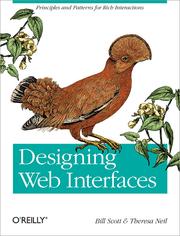Principles and Patterns for Rich Interactions
Want to learn how to create great user experiences on today’s Web? Designing Web Interfaces (O’Reilly) by UI experts Bill Scott and Theresa Neil presents more than 75 design patterns for building web interfaces that provide rich interaction. Distilled from the authors’ years of experience at Sabre, Yahoo!, and Netflix, these best practices are grouped into six key principles to help you take advantage of the web technologies available today.
“This book is about interaction design: specifically, interaction design on the Web,” note Scott and Neil. “And even more, ‘rich’ interaction design on the Web. It is a distillation of of best practices, patterns, and principles for creating a rich experience unique to the Web.”
By unique, the authors mean that the Web comes with its own context. It’s not the desktop. “And while over time the lines between desktop and Web blur more and more, there is still a unique aspect to creating rich interactions on the Web,” explains Scott. “Editing content directly on the page (e.g., In-Page Editing, as we discuss in Chapter 1) borrows heavily from the desktop—but has its unique flavor when applied to a web page. Our book explores these unique rich interactions as a set of design patterns in the context of a few key design principles.”
With an entire section devoted to each design principle, Designing Web Interfaces helps you:
Make It Direct: Edit content in context with design patterns for In Page Editing, Drag & Drop, and Direct Selection
Keep It Lightweight: Reduce the effort required to interact with a site by using In Context Tools to leave a “light footprint”
Stay on the Page: Keep visitors on a page with overlays, inlays, dynamic content, and in-page flow patterns
Provide an Invitation: Help visitors discover site features with invitations that cue them to the next level of interaction
Use Transitions: Learn when, why, and how to use animations, cinematic effects, and other transitions
React Immediately: Provide a rich experience by using lively responses such as Live Search, Live Suggest, Live Previews, and more
Designing Web Interfaces illustrates many patterns with examples from working websites. If you need to build or renovate a website to be truly interactive, this book gives you the principles for success.

